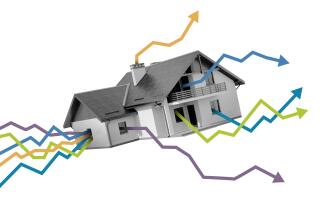Home prices hit new lows
- Share via
A key gauge of home prices in the nation’s largest cities fell in December to its lowest level since the start of the housing crisis in mid-2006.
The Standard & Poor’s/Case-Shiller index of 20 American cities fell 1.1% from November to December and 4% from December 2010. Eighteen out of the 20 cities tracked by the index posted declines and Atlanta, Las Vegas, Seattle and Tampa,Fla., each saw average home prices hit new lows.
“In terms of prices, the housing market ended 2011 on a very disappointing note,” said David M. Blitzer, chairman of the index committee at S&P Indices. “While we thought we saw some signs of stabilization in the middle of 2011, it appears that neither the economy nor consumer confidence was strong enough to move the market in a positive direction as the year ended.”
All of the California cities in the index posted declines from the prior month. Los Angeles, San Diego and San Francisco fell 1.1%, 0.7% and 0.8%, respectively. The drop continues a slide that began last year as sales weakened and the jobs picture remained bleak.
In December, Miami and Phoenix were the only two metro areas that posted monthly gains, up 0.2% and 0.8%, respectively.
A separate, national index published quarterly by S&P Case Shiller, also released Tuesday, showed deterioration in home values. The national composite fell by 3.8% during the fourth quarter of 2011 and was down 4.0% versus the fourth quarter of 2010.
The steep drops indicate that the housing market likely began 2012 in decline, as the broader economic recovery was not enough to lift home values. Home prices are now below their low hit in April 2009 -- reached during the depths of the financial crisis.
[Updated 7:53 a.m., Feb. 28: Robert Shiller, a professor at Yale University and co-creator of the index, said in a conference call Tuesday he was slightly more optimistic about housing’s future than he was a year ago, “but not that optimistic.”
“We are in a situation where a lot of people think, long-term, this is great, home prices are low,” Shiller said. “But somehow they think in the short-run … we are still in a holding pattern.”
Karl E. Case, the other co-creator of the index and a professor at Wellesley College, said he was more optimistic that the housing market would begin to improve given that, according to Census data, more U.S. households are being created, meaning there will be more demand for housing. If demand remains high -- and supply relatively low -- the housing market should begin to improve, he said.
“There are some bright spots,” he said.]
RELATED:
New-home builders suffered in SoCal in January
New-home sales fall in January, first drop in five months
Faulty reasoning keeps Fannie and Freddie out of foreclosure deal
More to Read
Inside the business of entertainment
The Wide Shot brings you news, analysis and insights on everything from streaming wars to production — and what it all means for the future.
You may occasionally receive promotional content from the Los Angeles Times.








